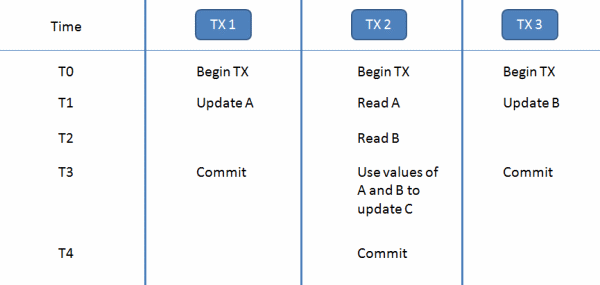One of the things that surprises some developers that I talk to is that you don’t always get consistency even with end-to-end synchronous communication and a single database. This goes beyond things like isolation levels that some developers are aware of and is particularly significant in multi-user collaborative domains.
The problem
Let’s start with an image to describe the scenario:

The main issue we have here is that the values transaction 2 gets for A and B are those from T0 – before either transaction 1 or 3 completed. The reason this is an issue is that these old values (usually together with some message data) are used to calculate what the new state of C should be.
Traditional optimistic concurrency techniques won’t detect any problem if we don’t touch A or B in transaction 2.
In short, systems today are causing inconsistency.
Some solutions
1. Don’t have transactions which operate on multiple entities (which probably isn’t possible for some of your most important business logic).
2. Turn on multi-version concurrency control – this is called snapshot isolation in MS Sql Server.
Yes, you need to turn it on. It’s off by default.
The good news is that this will stop the writing of inconsistent data to your database.
The bad news is that it will probably cause your system many more exceptions when going to persist.
For those of you who are using transaction messaging with automatic retrying, this will end up as “just” a performance problem (unless you follow the recommendations below). For those of you who are using regular web/wcf services (over tcp/http), you’re “cross cutting” exception management will likely end up discarding all the data submitted in those requests (but since that’s what you’re doing when you run into deadlocks this shouldn’t be news to you).
The solution to the performance issues
Eventual consistency.
Funny isn’t it – all those people who were afraid of eventual consistency got inconsistency instead.
Also, it’s not enough to just have eventual consistency (like between the command and query sides of CQRS). You need to drastically decrease the size of your entities. And the best way of doing that is to partition those entities across multiple business services (also known in DDD lingo as Bounded Contexts) each with its own database.
This is yet another reason why I say that CQRS shouldn’t be the top level architectural breakdown. Very useful within a given business service, yes – though sometimes as small as just some sagas.
Next steps
It may seem unusual that the title of this post implies that SOA is the solution, yet the content clearly states that traditional HTTP-based web services are a problem. Even REST wouldn’t change matters as it doesn’t influence how transactions are managed against a database.
The SOA solution I’m talking about here is the one I’ve spent the last several years blogging about. It’s a different style of SOA which has services stretch up to contain parts of the UI as well as down to contain parts of the database, resulting in a composite UI and multiple databases. This is a drastically different approach than much of the literature on the topic – especially Thomas Erl’s books.
Unfortunately there isn’t a book out there with all of this in it (that I’ve found), and I’m afraid that with my schedule (and family) writing a book is pretty much out of the question. Let’s face it – I’m barely finding time to blog.
The one thing I’m trying to do more of is provide training on these topics. I’ve just finished a course in London, doing another this week in Aarhus Denmark, and another next month in San Francisco (which is now sold out). The next openings this year will be in Stockholm, London; Sydney Australia and Austin Texas will be coming in January of next year. I’ll be coming over to the US more next year so if you missed San Francisco, keep an eye out.
I wish there was more I could do, but I’m only one guy.
Hmm, maybe it’s time to change that.